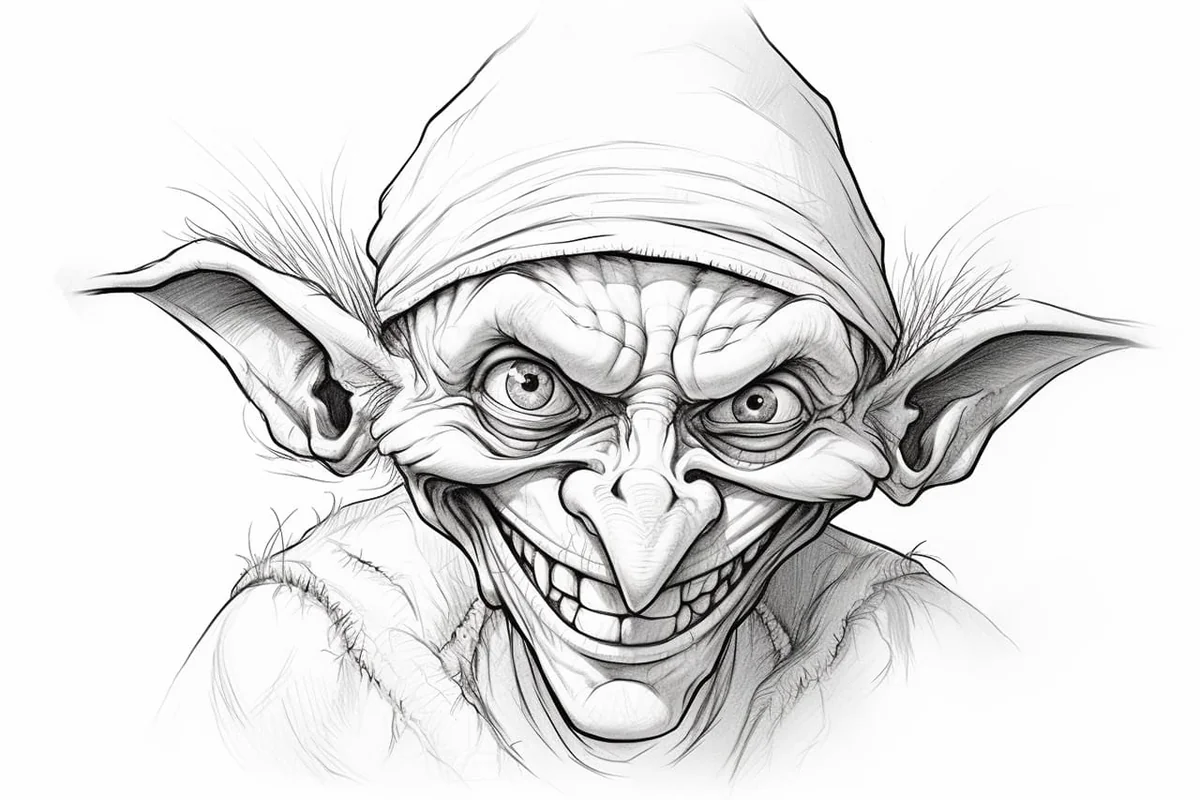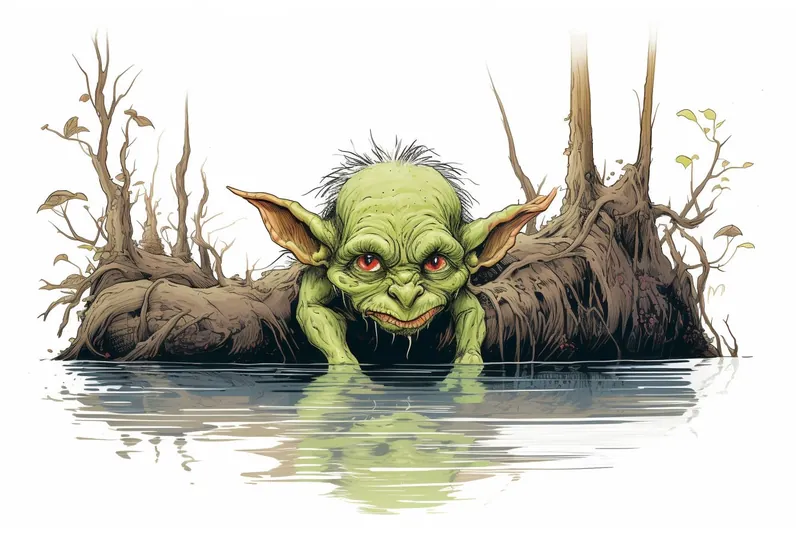How to Draw a Goblin in 10 Easy Steps
Learn how to draw with this step-by-step tutorial.

Materials You'll Need
- Drawing paper
- Pencil (HB or 2B)
- Eraser
- Colored pencils
- Markers
- Watercolor paints

Hey there! Ready to dive into the fun world of drawing? Today, we're tackling how to draw a goblin. Whether you're a seasoned artist or just picking up a pencil for the first time, I've got all the steps laid out for you to create a goblin that's uniquely yours. So, gather your drawing tools and let's get this creative party started!
Goblins are such intriguing creatures to bring to life on paper! They lurk in the shadows of folklore and fantasy, known for their mischievous spirits and often, quirky looks. When drawing your goblin, think about what sets them apart in the vast realm of mythical beings. Is it their sharp, pointy ears or the clever glint in their eyes?
As you sketch, imagine the world from which your goblin hails. Are they a forest dweller hiding under the twisted roots of ancient trees, or do they scurry through the bustling streets of a magical underground city? Each stroke of your pencil adds depth to their story, infusing personality into those crooked smiles or wrinkled, warty noses.
Embrace the freedom to experiment with colors and textures. Maybe your goblin has a leather vest stitched together from the remnants of lost travelers' belongings, or perhaps they boast a bright, patchy cap that's become a token of their daring adventures. Remember, the charm of a goblin lies in the details, so let your imagination run wild as you bring your own unique version to life!
Materials Required
Before we begin, make sure you have the following materials:
-
Pencils (preferably a range of 2B to 6B)
-
Pencil sharpener
-
Optional: Colored pencils or markers for adding color to your drawing
Now that you have your materials ready, let's dive into the step-by-step process of how to draw a goblin.
How to Draw a Goblin: A Step-by-Step Guide
Tip: As you draw your goblin, consider using references from various sources, such as folklore or fantasy art, to inspire unique features and poses. Explore different styles—like exaggerated expressions or whimsical attire—to inject your goblin with personality and charm. Don't hesitate to sketch multiple versions or variations, as experimenting can lead to exciting creative breakthroughs and a more dynamic character design!
Step 1: Start with Basic Shapes
simple geometric shapes
Draw a circle smaller oval
*These shapes serve as your construction lines, so don't worry about perfection just yet.*Step 2: Place the Facial Features
two intersecting lines
two oval-shaped eyes curved or hook-shaped nose wide, toothy grin****sharp teeth
large, pointy ears
*Want a spooky goblin? Tilt the eyes and add narrow pupils. Want a silly one? Make the features softer and rounder!*Step 3: Express the Goblin's Personality
eyebrows wrinkles or lines
*Every goblin tells a story. Let that story start with the face.*Step 4: Detail the Ears and Face
ear shapes****inner folds, jagged edges, or tears
small scars, warts, or veins
imperfect and organic****Step 5: Add Hair, Horns, or Extra Features
messy tufts of hairspiky mohawkbald with a few stray strands small horns piercingseyepatchesbandages
*The weirder, the better—let your imagination run wild!***Step 6: Build the Body and Limbs **
limbs
rectangles or tubes****curved lines skinny limbs and hunched posture neck or hunch
*Want an action pose? Angle the arms and legs as if they're in mid-leap or sneaking around.*Step 7: Draw Hands and Feet
Hands:rough palm shapepointed fingers****curled, reaching, or gripping something - Feet:flat, wide feetclawed toes
*Hands and feet are a great place to add character—maybe one finger is bandaged, or a toe is missing!*Step 8: Add Clothing and Gear
ragged and ill-fitting
*Think scavenger or forest bandit, and let your goblin's outfit tell part of their story.*Step 9: Refine and Add Detail
shading texture lines broken teeth, stitches, or grime Step 10: Color Your Goblin (Optional)
**Skin tones:**green, gray, blue, or even purplish hues Eyes: earthy tones highlights and shadows
You can use colored pencils, markers, digital tools, or even watercolor for a dynamic finish.
Conclusion: Your Goblin Is Alive!
Congratulations! You've summoned your own goblin from your imagination onto the page. With exaggerated features, expressive poses, and rugged charm, your goblin now has its own story and personality. Don't worry if it didn't turn out exactly how you envisioned—every sketch is a step forward in your artistic journey.
Keep practicing, experiment with different styles (cute goblins! evil warlords! goblin chefs!), and most importantly—have fun. Your fantasy world is just getting started. Happy drawing!
Gallery of Goblin Drawings







Suggestions for Scenes and Settings for Goblin Drawings
-
Deep in the Forest: A goblin lurking in a dense, dark forest, with twisted trees and thick underbrush, possibly near a hidden cave entrance.
-
Treasure Hoard: A goblin gleefully sitting atop a pile of treasure in its lair, surrounded by coins, jewels, and ancient artifacts.
-
Swampy Hideout: A scene depicting a goblin in a murky swamp, with fog, overgrown vegetation, and perhaps a rickety wooden hut as its home.
-
Mountain Pass: A goblin guarding a narrow mountain pass or bridge, with rocky cliffs and a view of the valley below.
-
Ancient Ruins: A goblin exploring or inhabiting ancient ruins, with broken columns, statues, and faded murals as the backdrop.
-
Underground Tunnel: A view of a goblin navigating the dark, narrow tunnels of an underground network, with dim light filtering through cracks.
-
Mystical Workshop: A goblin engrossed in crafting potions or magical artifacts, surrounded by bottles, books, and glowing ingredients.
-
Moonlit Raid: A goblin sneaking into a village or campsite under the cover of night, with only the moonlight casting shadows.
-
Battle Stance: A goblin ready for battle, standing in a defensive posture with makeshift armor and weapons, set against the backdrop of an impending skirmish.
-
Festive Gathering: A group of goblins celebrating around a fire in a clearing, with dancing, music, and feasting on wild game.
Each of these scenes provides a unique setting that can bring out the character and environment of a goblin, ranging from mysterious and menacing to whimsical and cunning.

Wild Inspiration: Imagine your goblin not just as a mischievous creature of the shadows, but as the vibrant guardian of a mystical carnival! Picture them adorned with an eclectic mix of vibrant fabrics and shimmering beads, each piece telling a story of their whimsical adventures. Their skin can be a kaleidoscope of colors, reflecting the bright lights of the carnival, while their eyes sparkle like the stars overhead.
Surround your goblin with fantastical elements like oversized, glowing mushrooms, balloon animals, and swirling confetti that dances in the air. This carnival is filled with laughter and wonder, so don't hold back—add playful creatures like tiny fairies or grumpy trolls selling cotton candy! Let this fusion of goblin folklore and carnival magic unleash your creativity and transport your audience to a realm of unexpected delight!